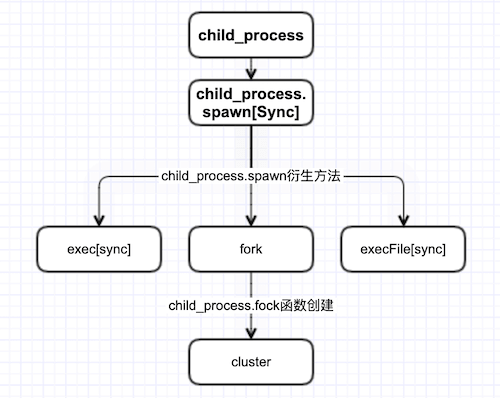进程是CPU分配资源的最小单位,分配独立内存,进程之间可通信,但是必须通过内核,使用IPC接口来做,代价比较大
线程是CPU调度的最小单位
javascript 语言本身被发明出来就是为浏览器服务的,所以为了在浏览器端渲染的界面的时候不会被来自不同金IC的数据干扰,js执行环境被设计成了单进程执行。
但是在作为Nodejs使用的时候,为了最大发挥服务器的多核优势,Nodejs也被安排了多进程的能力。而为其提供多进程能力的核心模块就是 child_process
child_process提供了衍生子进程的能力,主要由child_process.spawn()函数提供。
默认情况下, stdin、 stdout 和 stderr 的管道会在父 Node.js 进程和衍生的子进程之间建立,这些管道的容量是有限的。
child_process.spawn
nodejs还提供了一些基于child_process.spawn的一些替代方法,都是基于 child_process.spawn() 或 child_process.spawnSync() 实现的。
1
2
3
4
5
| child_process.exec(): 衍生 shell 并且在 shell 中运行命令,当完成时则将 stdout 和 stderr 传给回调函数。
child_process.execFile(): 类似于 child_process.exec(),但是默认情况下它会直接衍生命令而不先衍生 shell。
child_process.fork(): 衍生新的 Node.js 进程,并调用指定的模块,该模块已建立了 IPC 通信通道,可以在父进程与子进程之间发送消息。
child_process.execSync(): child_process.exec() 的同步版本,会阻塞 Node.js 事件循环。
child_process.execFileSync(): child_process.execFile() 的同步版本,会阻塞 Node.js 事件循环。
|
cluster
cluster模块是基于child_process.fork方法创建的,它可以使用IPC和父进程进行通信。

cluster 模块可以创建共享服务器端口的子进程,因此常常被用作nodejs的多进程部署,pm2的cluster模式就是利用了此方法。
1.利用cluster创建子进程的方法
1
2
3
4
5
6
7
8
9
10
11
12
13
14
15
16
17
18
19
| const cluster = require('cluster')
const http = require('http')
const numsCPUS = require('os').cpus().length
if (cluster.isMaster) {
console.log(`Master ${process.pid} is running`)
for( let i = 0; i < numsCPUS.length; i++) {
cluster.fork()
}
cluster.on('exit', (worker, code, signal) => {
console.log(`worker ${worker.process.pid} died`)
cluster.fork()
})
} else {
http.createServer((req, res) => {
res.writeHead(200)
res.end('hello world\n')
}).listen(8000)
console.log(`worker ${process.pid} started`)
}
|
2.cluster实现原理
cluster其实就是对于child_process模块的封装,通过child_procress.fork()出子进程,同时基于IPC实现了与master进程之间的通信。
master进程创建一个socket,并绑定监听到该目标端口,通过与子进程之间建立IPC通道,调用子进程的send方法,将socket(链接句柄)传递给子进程,大致实现如下。
1
2
3
4
5
6
7
8
9
10
11
12
13
14
15
16
17
|
const { fork } = require('child_process')
const cpus = require('os').cpus()
const net = require('net')
const workers = []
for (let i = 0; i < cpus.length; i++) {
workers.push(fork('./worker.js'))
}
const handle = net._createServerHandle('0.0.0.0', 8000)
handle.listen()
handle.on('connection', (err, handle) => {
const worker = workers.pop()
worker.send({}, handle)
workers.unshift(worker)
})
|
子进程的接收到来自主进程的消息以及句柄之后
1
2
3
4
5
6
7
8
|
const net = require('net')
process.on('message', (message, handle) => {
const socket = new net.socket({ handle })
socket.readable = true
socket.writable = true
socket.end(['data', message])
})
|
相关链接
Nodejs cluster模块深入探究
Nodejs 进阶:解答 Cluster 模块的几个疑问
pm2的cluster模式与fork模式的区别
浏览器进程与线程梳理
cluster子进程重启方案
cluster 模块的实现原理
